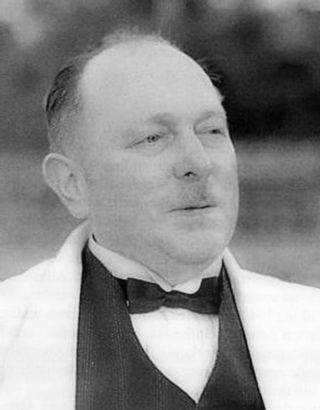
Ruth Dreifuss is a Swiss economist, unionist and politician who served as a member of the Federal Council (Switzerland) from 1993 to 2002. She served as Vice President of Switzerland in 1998 and as President of Switzerland in 1999 for the Social Democratic Party.

The Bugatti Type 41, better known as the Royale, is a large luxury car built by Bugatti from 1927 to 1933, With a 4.3 m (169.3 in) wheelbase and 6.4 m (21 ft) overall length, it weighs approximately 3,175 kg (7,000 lb) and uses a 12.763 litre (778 cu in) straight-eight engine. For comparison, against the Rolls-Royce Phantom VII, the Royale is about 20% longer, and more than 25% heavier. This makes the Royale one of the largest cars in the world. Furthermore, with the limited production run and the premium nature of the vehicle, it is also both one of the rarest and most expensive.

Julius Baer was a Kingdom of Württemberg-born Swiss banker, businessman and philanthropist. Baer was the founder and namesake of Julius Baer Group, and the patriarch of the Baer family.

Musée National de l’Automobile, Collection Schlumpf is an automobile museum located in Mulhouse, France, and built around the Schlumpf Collection of classic automobiles. It has the largest displayed collection of automobiles and contains the largest and most comprehensive collection of Bugatti motor vehicles in the world.

Werner Kurt Rey is a UK-based Swiss businessman, financier and convicted fraudster. In 1976, Rey acquired the fashion house Bally, and subsequently sold it to the Oerlikon Bührle concern, which laid the foundation of his Omni Holding AG, which would at its peak have assets under management exceeding $4 billion.

Alfred Vogt was a Swiss ophthalmologist, known for his development of techniques for retinoscopy and the surgical management of retinal detachment.
Schlumpf is a surname. It is also the German word for smurf. Notable people with the surname include:

Stephanie Glaser was one of Switzerland's most prominent stage, TV and film actresses, popular for her portrayal of down-to-earth, sympathetic characters.

Urs Christian Timotheus Guldimann abbreviated as Tim Guldimann is a Swiss political scientist and former diplomat and politician who previously served on the National Council (Switzerland) for the Social Democratic Party from 2015 to 2018. He was the first Swiss abroad ever elected to federal office.

Samuel Jacob Frey was a Swiss industrialist, financier and politician. He is best known for founding the Freya Paper Company, today known as Elco AG, in 1884. Frey served as a member of the Grand Council of Aargau from 1901 to 1921 for the Free Radical Liberals.
Hans Jakob Vontobel was a Swiss private banker and philanthropist. He was the former president of Vontobel between 1984 and 1994 and honorary president until his death. He held approximately 20% of controlling shares of the private bank. He was the patriarch of the Vontobel banking family.

Gustav Adolf Bühler commonly referred to as Adolf Bühler Jr. was a Swiss industrialist, philanthropist and politician. He was the eldest son of Adolf Bühler and majority owner of Bühler Brothers. Bühler served on the Cantonal Council of St. Gallen from 1898 to 1906 for the Free Radical Liberals. He was a member of the Bühler family.

Max René Bühler was a Swiss businessman, industrialist and politician. He served on the National Council (Switzerland) for the Free Democratic Party (FDP) between 1951 and 1959. He previously served on the municipal council of Uzwil between 1948 and 1951.

George Ham Page commonly referred to as General Page was an American industrialist who co-founded the Anglo-Swiss Condensed Milk Company in 1866, a predecessor of Nestlé. He was primarily active in Switzerland. He was also one of the founders of the Orange County Milk Association in Middletown, New York. He was the grandfather and namesake of alpine skier George Page.

Bertrand Othmar Vogt known bis his initials B.O. Vogt was a Swiss industrialist, philanthropist and politician. He served on the Grand Council of Aargau from 1909 to 1917 for the Free Democratic Party. He was controlling shareholder and president of Hediger Sons, a tobacco manufacturing concern, which was later integrated in Villiger Sons. Since 1908 he was also a member of the Aargau Natural Research Society and since 1920 he served on the Board of Directors of Bank in Menziken. He has also been a major investor into Fischer Reinach.

Joseph August Rohner commonly known as Anton Rohner was a Swiss clergyman, professor, pastor, philosopher and member of the Dominican Order. Since 1940, he served as principal of the University of Fribourg. He was a great-uncle of Albert Ziegler.

Jakob Friedrich Wanner was a German-born Swiss architect who was primarily active in Zürich, Switzerland. Among his notable works are the headquarters of Credit Suisse at Paradeplatz and Zurich Main Station.
George Henry Mueller is a Brazilian-born Swiss businessman who currently serves as Honorary Consul General of Japan to Zürich, Switzerland.

Hediger Sons was a former Swiss tobacco manufacturing company which was merged with Villiger Sons in 1971. It was among the largest and second oldest manufacturing company for cigars and cigarillos in the Wynental valley.

Verena "Vreni" Spoerry is a Swiss attorney, business executive and former politician who served on the Council of States (Switzerland) for the Free Democratic Party from 1996 to 2003. She previously served on the National Council of Switzerland from 1983 to 1996.



















